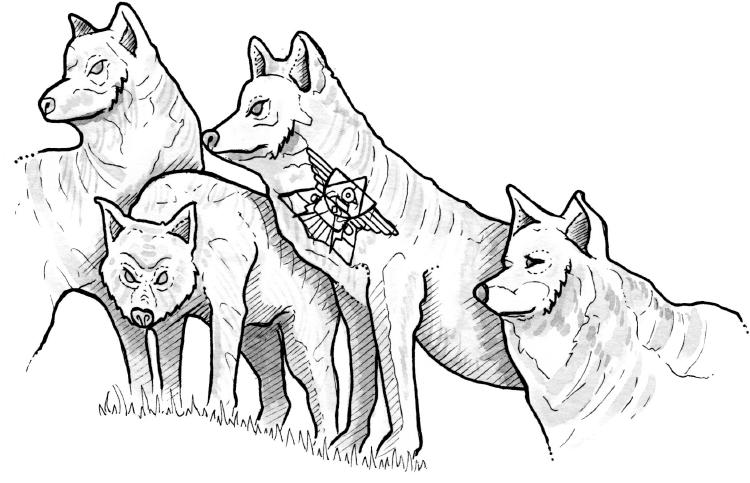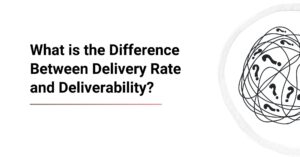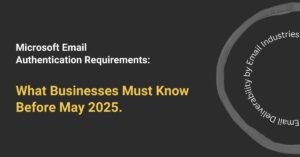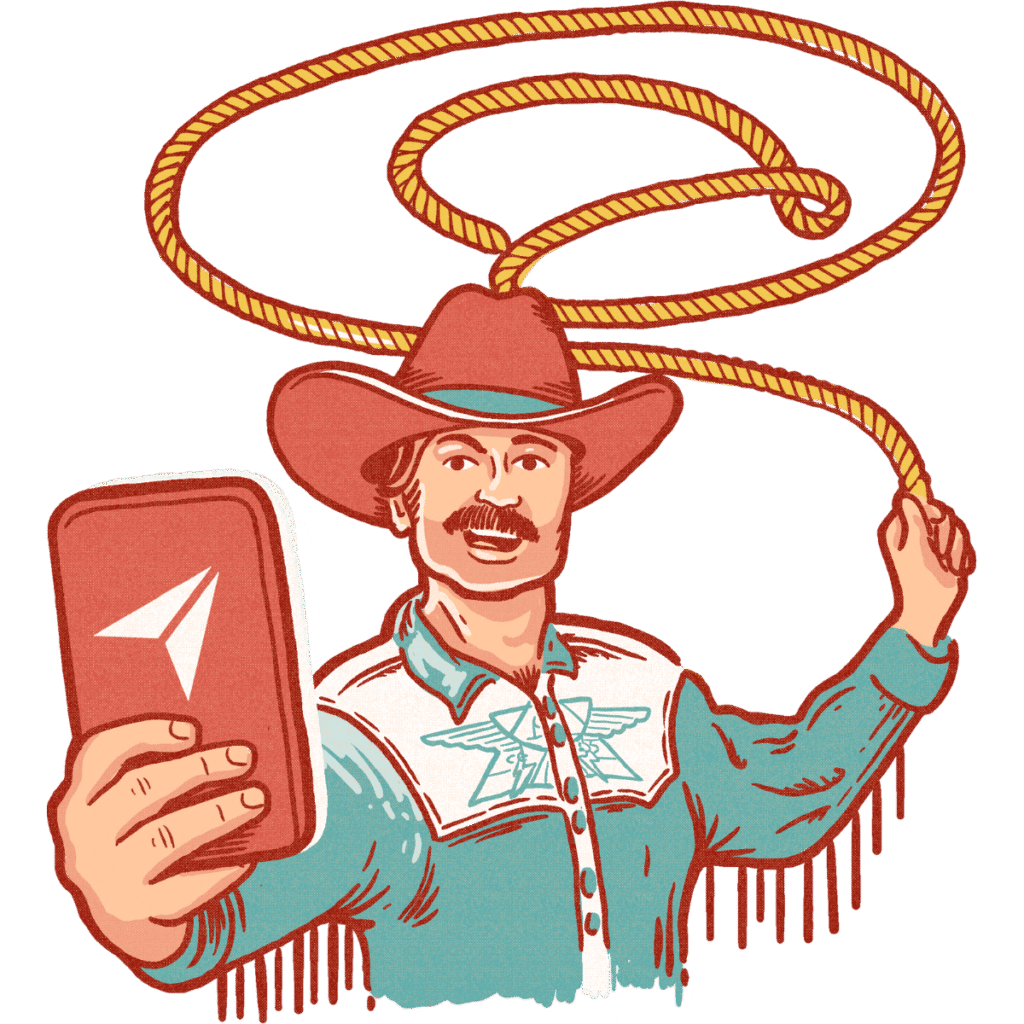Getting the audience’s attention is one thing; converting that attention into a sale is quite another. The trouble is that many people who subscribe to your newsletters aren’t quite ready to make a purchase. That is where lead nurturing enters the frame.
Nurture campaigns focus on turning prospects into paying customers through a series of marketing emails. With the right strategy, a nurture campaign can help you better identify the target audience, turn potential customers into loyal patrons, expand your customer base, and increase revenue sustainably.
In this blog post, we explore the fundamentals of a nurture campaign, learn the differences between a drip campaign, study 10 real-world examples of lead nurturing emails, and demonstrate how to build a nurture campaign from scratch.
What is a Nurture Email Campaign? (And Why Should You Care?)
A nurture campaign is an email series designed to persuade potential customers to journey through the sales funnel. As the name suggests, nurture campaigns help businesses nurture relationships with potential customers. This email marketing strategy converts prospects into paying customers with the help of clever marketing techniques.
Nurture campaigns establish personalized and meaningful connections between a business and its customers by providing valuable content. Unlike a drip campaign that relies on sending emails automatically to people who take specific actions on your website, a nurture campaign builds relationships by creating value.
A nurture campaign offers maximum value to the customer by helping them overcome challenges and achieve their goals. These campaigns generally include email sequences specific to the situation. For example, the emails are usually informative at the start of the campaign. They help introduce the brand and familiarize customers with the products or services on offer.
As prospects approach the conversion stage of the sales funnel, the emails become more promotional. Messages include discounts or promo codes, trial offers, cashback guarantees, and abandoned cart notifications to influence prospects to complete a purchase.
Nurture campaigns play a significant role in increasing conversion rates and retaining customers. This is because 96% of website visitors aren’t ready to purchase yet. However, they might bring their business in the future. This is enough reason to build relationships. When done correctly, nurture campaigns can significantly improve conversion rates, increase revenue, and generate profits.
10 Lead Nurturing Campaign Examples
An email nurture campaign consists of layers of email messages. Here are 10 real-world examples to inspire your next campaign:
Welcome Email
As the name suggests, a welcome email is the first email subscribers receive when they sign up for your newsletters. Use this email to introduce your brand and your products or services. You should thank subscribers for opting in for your marketing emails and explain the next steps they can take, such as exploring your website, social pages, or eCommerce store. If the person signed up using a lead magnet, add a link to the download.

This welcome email from MarketingProfs influences subscribers to take specific actions via useful links and offers a 20% discount to initiate a purchase. Don’t miss how the body copy highlights the product’s benefits and effortlessly drives readers down the sales funnel.
Cart Abandonment Email
Cart abandonment emails remind potential customers to complete the purchase. They are autonomously triggered when a prospect leaves the checkout midway with a product or service waiting in the cart. Cart abandonment reminders are vital for eCommerce brands as they influence potential buyers to complete the purchase.
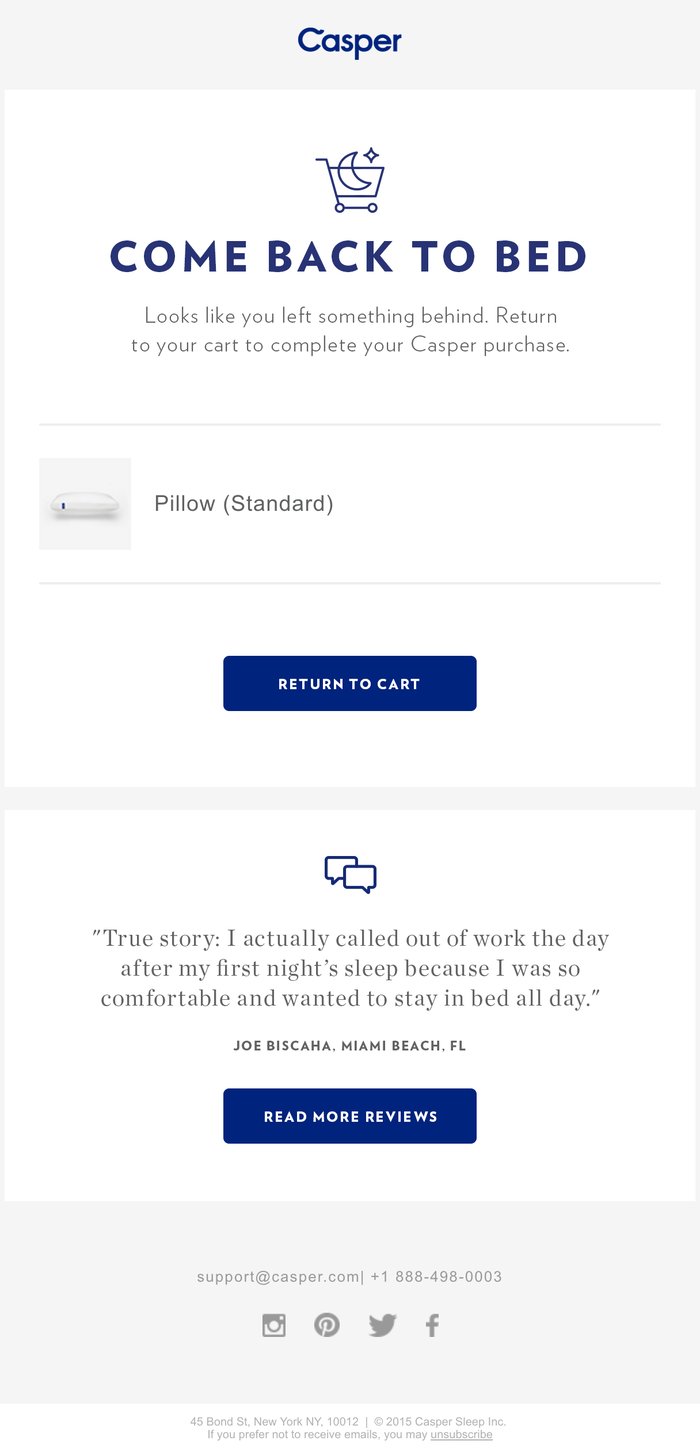
This cart abandonment email from Casper stands out because of its simple design and witty heading. Don’t miss the strategic testimonial, which adds social proof. The two CTAs and the clever use of white space are the highlights of this email.
Social Proof
Social proof is a powerful motivator that trumps even your loftiest claims. Intelligent marketers leverage social proof to highlight what existing customers are saying about a business. You can add social proof to your email campaigns by:
- Adding testimonials in the email body
- Linking to reviews on reputable third-party websites
- Sharing in-depth case studies
- Embedding social posts where customers are praising your brand
Try to include social proof of customers praising your brand and highlighting how your products or services have helped solve their problems or added value to their lives.

In this example from Duolingo, the company uses two testimonials from teachers using their service. Notice the three-layered campaign, starting with nominating the best teacher for a chance to win a prize. The second layer mentions the exact number of teachers (350,000) using the app. The final layer adds social proof. The campaign leverages reader participation to increase the chances of conversion.
Promotional Email
Discounts and offers are excellent sales motivators in the later stages of the buyer’s journey. If a prospect is almost ready to make a purchase, sending a discount coupon influences them to take action immediately.

In this example, Thrive Market offers a 25% discount on the first order. The expiration date adds urgency, while the CTA is cleverly placed above the fold. Notice how the offer is repeated towards the end and highlighted in bright blue. This helps the message stand out and emphasize the offer.
Webinar Invites
Webinars are excellent for establishing authority in your industry and positioning your brand as a thought leader. When people sign up for webinars, you get two significant pieces of information:
- Knowledge of a specific problem and the number of people who want a solution
- The number of people who invested in learning about your brand
You can use this information to position your brand around delivering solutions by creating or sharing valuable content.

This email from Rock Content invites people to a webinar about a common problem most entrepreneurs face. Notice how the speaker and brand are positioned as industry authorities.
Exploratory Emails
Nurture email campaigns can be used to learn more about subscribers’ problems. There are three main ways to gather data:
- Add a link to your preferences center so subscribers can choose the type of content to receive
- Segment subscribers based on the email links they click
- Launch a survey email campaign asking questions and grouping recipients based on their answers
Once you identify your subscribers’ likes, interests, and problems, you can create email content around these points.

In this example, Brightly lets readers choose their ideal book recommendations based on requirements. This allows the company to track users based on which link they click and save their preferences for automatic book recommendations in the future.
Product Updates
Product update emails are a great way to keep subscribers engaged with your brand. Informing potential customers of exciting new features in your products can motivate them to make a purchase.

In this example, Adalo introduces new performance updates to its app builder. Notice the bold claim in the headline, followed by bulleted benefits and the highlighted call to action with a clear message. The body copy explains the benefits introduced in the update, with a second CTA inviting readers to learn more.
Product Explainers
Nurture campaigns are excellent for explaining the benefits of your products or services to customers. They help build trust and streamline the buying process, especially when a customer is at the consideration stage of the buyer’s journey.

This product explainer email example from Ezoic shares valuable information about the topic and helps readers learn more by linking additional resources. The main focus of this campaign is to point readers toward a blog post, although a product link is cleverly inserted.
Educational Content
Educational emails position a brand’s products and services as solutions to prospects’ problems. By solving a pain point, the brand establishes itself as a trusted source of information and an industry authority. Thus ensuring people read future emails for more solutions. This helps build brand awareness and customer loyalty.

In this example, Zapier shares an informative guide on how to create an email assistant using GPT. The CTA asks readers to sign up and create the automated solution. The email campaign identifies subscribers based on problems and offers solutions to build trust.
Newsjacking
This email campaign promotes a business by capitalizing on the popularity of breaking news. By cultivating a trending news story, you can introduce your brand to a new audience that is already discussing the topic.
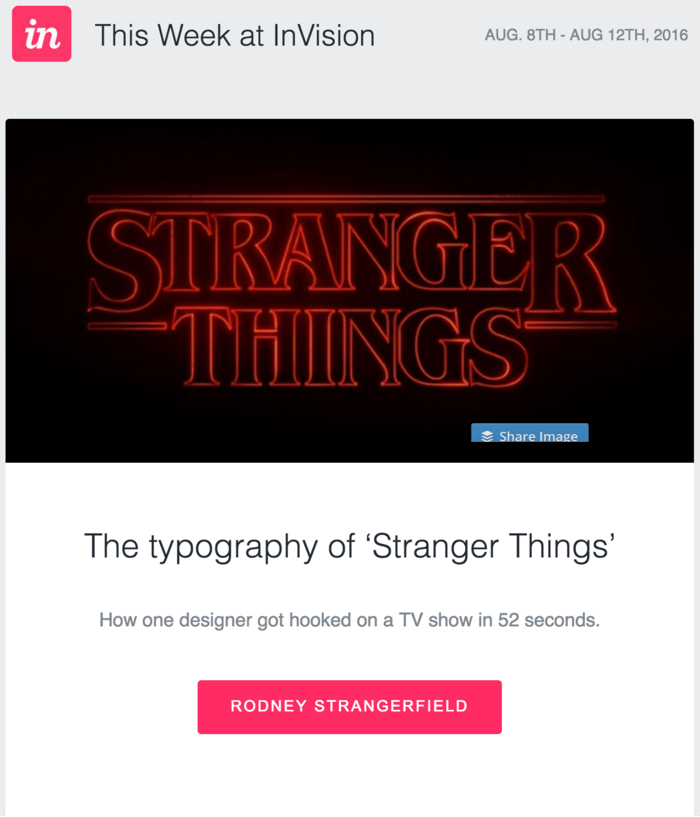
In this example, Invision leverages the popularity of Stranger Things to bring readers’s attention to the design industry. Notice how the CTA follows the curiosity gap in the body copy. If you’re a Stranger Things fan, you will be tempted to click the CTA button. That is the brilliance of a newsjacking campaign.
How to Create Lead Nurturing Email Marketing Campaigns
There are several ideas to implement in order to supercharge your email marketing efforts. Here are some proven strategies for creating a lead nurturing email marketing campaign:
Identify Your Audience
Lead nurturing emails work best with a segmented email list since it allows marketers to target the audience based on specific categories. For example, you can segment subscribers based on demographics like location, industry, interests, company size, and role.
You can also segment subscribers based on their position in the sales funnel, such as those who signed up for newsletters, webinars, demos, etc., engaged with previous emails, downloaded a content asset or resource, or used a specific feature during the free trial.
Define Your Goals
A nurture campaign is critical for converting prospects into paying customers. So, before creating email sequences, you need to consider the desired outcome and build your strategy accordingly. Here are the most popular lead nurturing email goals:
- Purchase a product or a service
- Book a sales call or demo
- Attend a webinar
- Opt-in for a free trial
- Download a content asset
- Watch a product explainer video
Choose a goal that makes sense for your business and create a lead nurturing email marketing campaign around this goal.
Chart the Buyer’s Journey
Lead nurturing emails deliver better results if you deeply understand the buyer’s journey. If you know your customers prefer free shipping over a 10% discount, you can create more effective campaigns. Analytics tools provide the data required for identifying user behavior. Communicate with customers for further insights into their buyer’s journey. This technique is more effective when you have a limited number of customers.
Create Valuable Content
The most challenging part of email marketing is creating valuable content that compels subscribers to take the desired action. To move people to the next stage of the buyer’s journey, you need diverse content, from welcome and promotional emails to surveys, forms, resource videos, content assets, and reports.
Here are four tips for generating content ideas that appeal to your target audience:
- Study the content types and topics that generate significant interest in your industry
- Research the content your competitors are creating
- Ask subscribers about their biggest challenges
- Analyze your website and social channels to find your most popular content
Establish Email Automation Triggers
Lead nurturing automation helps convert future customers without your interference. Use your email service provider to create automated workflows based on action triggers. Email Industries can help automate your email sequences so that you can gain customers even while you’re offline. Click here to talk to an expert today.
Run A/B Tests and Implement Your Findings
Testing is the most vital part of email marketing. Once your campaign goes live, check the analytics dashboard to measure performance. Use these insights to optimize your email campaigns for better results. Test different subject lines, body copy, visual elements, sender name, sending schedules, etc., to see what works best for your brand.
Nurture Leads and Skyrocket Conversions with Expert Guidance
An effective lead nurturing campaign is essential for building trust and increasing conversion. Hence, lead nurturing emails are integral to your marketing efforts. Don’t let the initial failures demotivate you if you’re new to email marketing. Keep experimenting, testing, and learning about your audience. Eventually, you will discover the perfect strategy.
If you want to skip the hassle, book a discovery call now and learn how our marketing experts can generate leads and convert prospects into paying customers with proven strategies.
